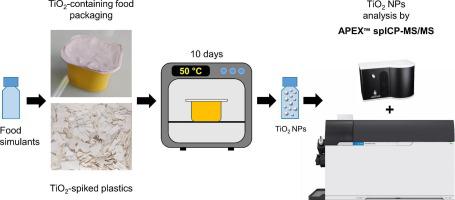当前位置:
X-MOL 学术
›
NanoImpact
›
论文详情
Our official English website, www.x-mol.net, welcomes your feedback! (Note: you will need to create a separate account there.)
Assessment of TiO2 (nano)particles migration from food packaging materials to food simulants by single particle ICP-MS/MS using a high efficiency sample introduction system
NanoImpact ( IF 4.9 ) Pub Date : 2024-03-20 , DOI: 10.1016/j.impact.2024.100503 Isabel Bastardo-Fernández , Rachida Chekri , Caroline Oster , Valentin Thoury , Paola Fisicaro , Petru Jitaru , Johanna Noireaux
NanoImpact ( IF 4.9 ) Pub Date : 2024-03-20 , DOI: 10.1016/j.impact.2024.100503 Isabel Bastardo-Fernández , Rachida Chekri , Caroline Oster , Valentin Thoury , Paola Fisicaro , Petru Jitaru , Johanna Noireaux

|
TiO is the most widely used white pigment in plastics and food packaging industry, thus the question of its migration towards food and hence the impact on consumers is raised. Since recent research indicate its potential toxicity, it is necessary to study TiO contamination as a consequence of food storage. For this purpose, plastic containers from commercially-available dairy products and custom-made TiO-spiked polypropylene materials were put in contact with 50% () ethanol and 3% () acetic acid, which were used here as food simulants. The migration assays were carried out under standard contact conditions of packaging use (as recommended by Commission Regulation (EU) N° 10/2011 for food contact migration testing), and under conditions of extreme mechanical degradation of the packaging. The TiO (nano)particles released in the food simulants were analysed by single particle inductively coupled plasma-tandem mass spectrometry in mass-shift mode and using a high efficiency sample introduction system (APEX™ Ω) to avoid matrix effects from food simulants. For the dairy product containers and for the spiked polypropylene, results showed release of TiO particles of rather large sizes (average size: 164 and 175 nm, respectively) under mechanical degradation conditions, i.e. when the polymeric structure is damaged. The highest amounts of TiO were observed in 50% ethanol after 10 days of storage at 50 °C (0.62 ng cm) for the dairy product containers and after 1 day of storage at 50 °C (0.68 ng cm) for the spiked polypropylene. However, the level of Ti released in particle form was very small compared to the total Ti content in the packaging and far below the acceptable migration limits set by European legislation. Release under standard contact conditions of use of the container was not measurable, thus the migration of TiO particles from this packaging to dairy products among storage is expected to be negligible.
中文翻译:

使用高效进样系统通过单颗粒 ICP-MS/MS 评估 TiO2(纳米)颗粒从食品包装材料到食品模拟物的迁移
TiO 是塑料和食品包装行业中使用最广泛的白色颜料,因此提出了其向食品迁移以及对消费者影响的问题。由于最近的研究表明其潜在毒性,因此有必要研究食品储存造成的二氧化钛污染。为此,将市售乳制品和定制的掺有 TiO2 的聚丙烯材料制成的塑料容器与 50% () 乙醇和 3% () 乙酸(此处用作食品模拟物)接触。迁移测定是在包装使用的标准接触条件下(根据委员会法规 (EU) N° 10/2011 关于食品接触迁移测试的建议)以及包装极端机械降解的条件下进行的。通过单颗粒电感耦合等离子体串联质谱法以质量转移模式分析食品模拟物中释放的 TiO(纳米)颗粒,并使用高效样品引入系统 (APEX™ Ω) 以避免食品模拟物的基质效应。对于乳制品容器和加标聚丙烯,结果显示在机械降解条件下,即当聚合物结构受损时,会释放出相当大尺寸的 TiO2 颗粒(平均尺寸分别为 164 和 175 nm)。对于乳制品容器,在 50°C (0.62 ng cm) 下储存 10 天后,在 50% 乙醇中观察到最高含量的 TiO2;对于加标聚丙烯,在 50°C (0.68 ng cm) 下储存 1 天后,观察到 TiO2 含量最高。然而,与包装中的总钛含量相比,以颗粒形式释放的钛含量非常低,并且远低于欧洲立法规定的可接受的迁移限值。在容器使用的标准接触条件下的释放是不可测量的,因此二氧化钛颗粒从该包装迁移到储存期间的乳制品中预计可以忽略不计。
更新日期:2024-03-20
中文翻译:

使用高效进样系统通过单颗粒 ICP-MS/MS 评估 TiO2(纳米)颗粒从食品包装材料到食品模拟物的迁移
TiO 是塑料和食品包装行业中使用最广泛的白色颜料,因此提出了其向食品迁移以及对消费者影响的问题。由于最近的研究表明其潜在毒性,因此有必要研究食品储存造成的二氧化钛污染。为此,将市售乳制品和定制的掺有 TiO2 的聚丙烯材料制成的塑料容器与 50% () 乙醇和 3% () 乙酸(此处用作食品模拟物)接触。迁移测定是在包装使用的标准接触条件下(根据委员会法规 (EU) N° 10/2011 关于食品接触迁移测试的建议)以及包装极端机械降解的条件下进行的。通过单颗粒电感耦合等离子体串联质谱法以质量转移模式分析食品模拟物中释放的 TiO(纳米)颗粒,并使用高效样品引入系统 (APEX™ Ω) 以避免食品模拟物的基质效应。对于乳制品容器和加标聚丙烯,结果显示在机械降解条件下,即当聚合物结构受损时,会释放出相当大尺寸的 TiO2 颗粒(平均尺寸分别为 164 和 175 nm)。对于乳制品容器,在 50°C (0.62 ng cm) 下储存 10 天后,在 50% 乙醇中观察到最高含量的 TiO2;对于加标聚丙烯,在 50°C (0.68 ng cm) 下储存 1 天后,观察到 TiO2 含量最高。然而,与包装中的总钛含量相比,以颗粒形式释放的钛含量非常低,并且远低于欧洲立法规定的可接受的迁移限值。在容器使用的标准接触条件下的释放是不可测量的,因此二氧化钛颗粒从该包装迁移到储存期间的乳制品中预计可以忽略不计。



























 京公网安备 11010802027423号
京公网安备 11010802027423号